Rites of Spring
 04.14.2012
04.14.2012 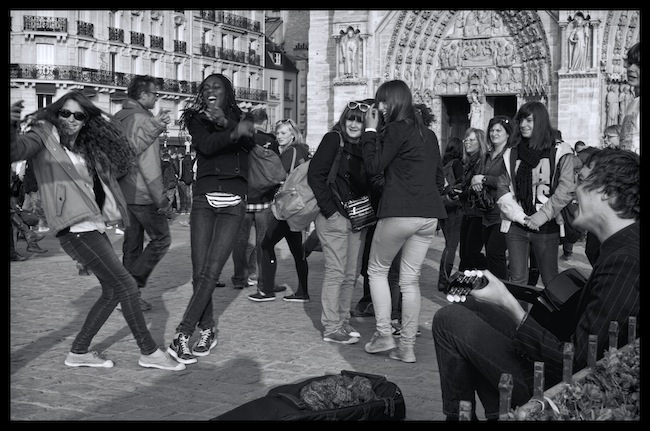
To watch us dance is to hear our hearts speak. --Hopi saying
Spring has arrived, fickle and schizoid here in Paris. One day summer, next day winter. Sometimes one minute summer, one minute winter.
And with spring comes hordes of tourists, and the ubiquitous buskers. And photographers to chronicle them; in this case Paris Play's staff photographer trying out a newly refurbished 35mm 1.8 prime lens on the Nikon.
Good Friday, time to honor the death of the god, who, in the case of the Christian faith, will arise just a few days later to taste the chocolate bunnies. The cycle of death and rebirth, a staple feature of myth and religion, also calls Dionysus, precursor of Christ, to mind.
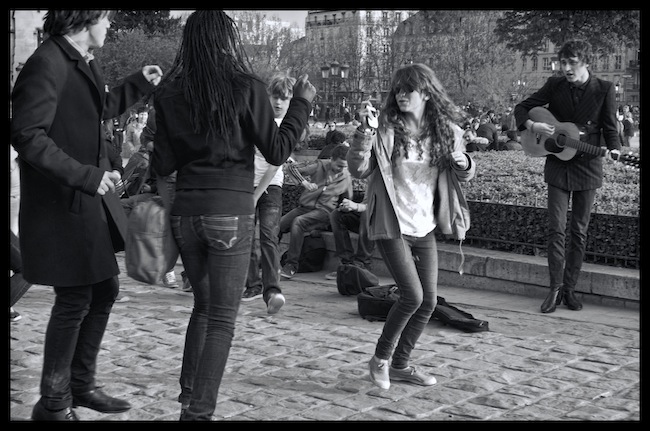
This Carnaby Street-influenced Dionysus unsheathed his guitar (a later variant of Hermes' lyre) at the plaza in front of Notre Dame and quickly drew a small crowd. They began, as Maenads have since time immemorial, spontaneously dancing, much to his delight.
And they grew wilder.
And wilder.
All this within thirty seconds.
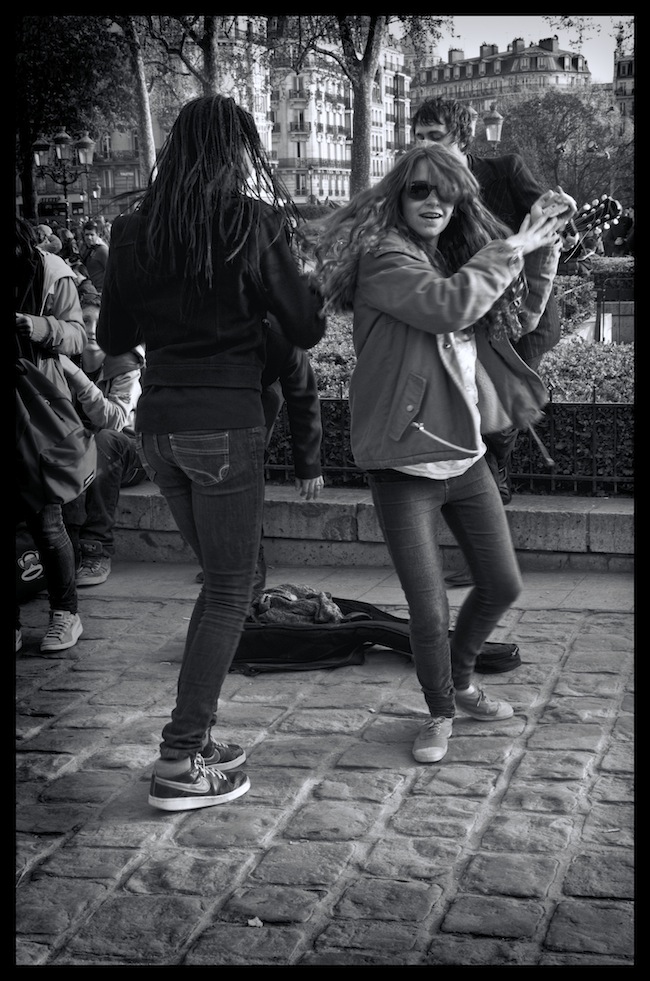
Of course, it is illegal to busk, and to break out in dance, in front of Quasimodo's cathedral. Years ago, when we were young and looked like this, and similarly gathered in Vina del Mar Park, the small downtown square in Sausalito, California, the city fathers had an easy remedy: they closed the park to ANYONE for the next thirty years. A generation. That'll teach those hippies. And their children.
Here in Paris, they don't close the Notre Dame Parvis, but they can stop the dance.
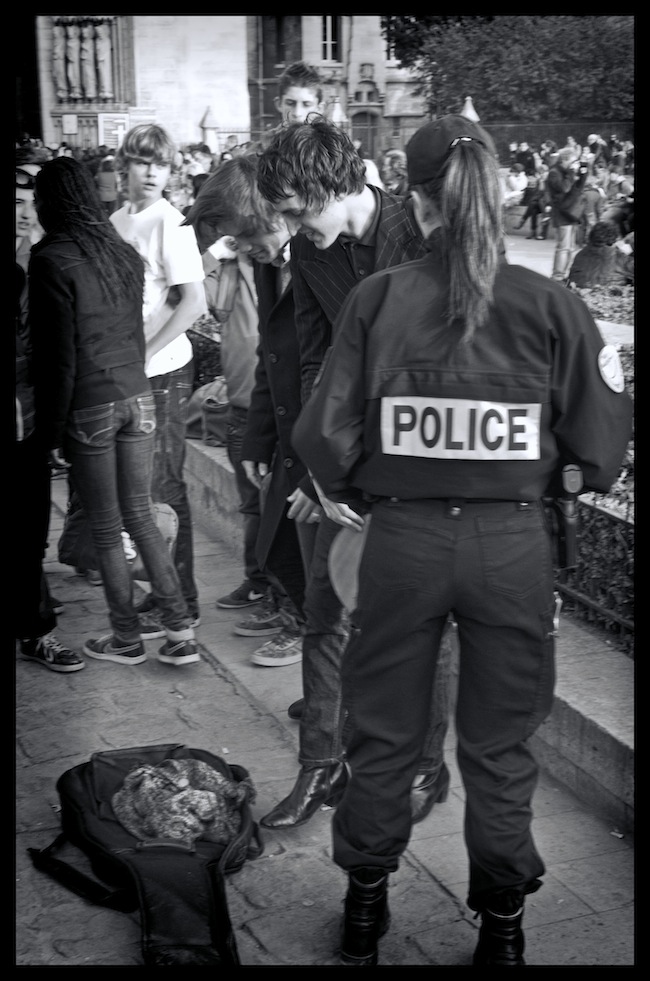
Lest we seem to demonize the officer in question, seconds after giving the busker the bum's rush (he left politely, as did the Maenads), she was back to graciously performing one of her other duties, advising a pair of tourists how to get from point A to point B in this radial and confusing city. Good cop/bad cop all in one package. Another daily Paris Play.
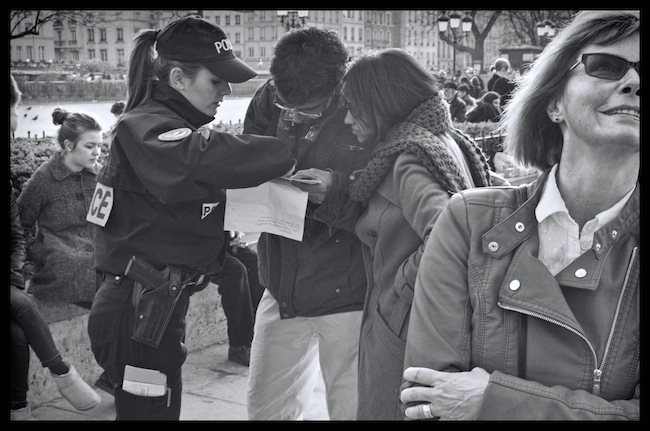


Reader Comments (11)
From one generation to the next, to the next, dance unites and somehow shows our wild side. (Why, I have no clue. They weren't even naked.) And Richard's photos, in black and white, feel timeless. Them was us.
And what you said about closing down a northern Cal park reminds me of a beautiful southern Cal park called Lacey, where we all congregated to sit in the trees and dream, and that closed for the same reason -- and is STILL closed forty years later.
(They open on weekends!)
"...to Itchycoo Park, that's where I've been...what did you do there?....."
Ah, bureaucracy. You can't live with it, you can't shoot it....
Hi, Anna:
I'm pretty sure it was Warner Brothers Records which, for a time in the Sixties, used the slogan, "The Man Can't Bust Our Music" in their ads in the likes of Rolling Stone. Perhaps. But The Man sure got off on busting US.
Forty years! Even more outrageous.
Much love,
Richard (and Kaaren)
Hi Kaaren,
I love that you mention Euripides' The Bacchae in your intro. In the Sixties the usual suspects such as Todd Gitlin, Tom Hayden, Jerry Rubin, and Abbie Hoffman worked incessantly to force-fit the American youthcult rebelliousness into an erroneous archetype--what they sincerely believed was an inevitable next-step-toward-the-revolution workings of the Hegelian dialectic. The young French rebels (Foucault, Derrida) who, in 1968, likewise failed to topple their government in the name of neo-Marxism, then turned their attentions to deconstructing the genuine cultural products of literature. In doing so, they are given credit for ushering in post-structuralism, of course, but also Post-modernity.
Yet, if we view the post WWII sense of malaise so well articulated by the Beat underground writers and manifested society-wide through rebellious, free-spirited Western youth a decade later, then with a very different archetypal lens, we can better appreciate how we arrived in the 1980s at the same jaded Post-modernity. Would a French (assuredly male) cop have dared to stop a street singer and those dancers during the midst of the most riotous days of 1968? What is the City-State of Paris, France afraid of with these dancing maenads?
In other words, The Bacchae, with its brilliant articulation of how the "City-State" becomes rejected when the spirit of Dionysus is ignored or suppressed, serves as the more accurate archetype for understanding the 1960s phenomenon. This widespread collective psychological/social response fits into the grand metaphor, the iconoclasm and free-spirited rebelliousness of the Maenads who celebrate Dionysus with their excess. This helps us understand the primal response at work in the 1960s when a bad war, anti-discrimination, anti-colonialism, sexism, psychedelics, The Pill, and vibrantly amplified rock music coalesced.
How rare compared to the ubiquitous coup d'etat or violent revolutions, but this tumultuous cauldron of change of the late '60s and early '70s was accurately the greatest Bacchanalian outburst that the world has ever witnessed.
In the US, when things quieted, the head of Pentheus was paraded on the end of a sharp stick. There was no going back to the consciousness of King Eisenhower, though. But clearly, beyond the conclusion of "The Bacchae", a spirit of jaded "post-classicism" (?!!?) (post-modernity, today) surely pervaded a City-State that wasn't destroyed, but dialectically transformed.
Euripides, more then Hegel, helps us comprehend the nature of the Sixties' Revolution. The question today is what will transform post-modernity. With our ontologically inevitable state of ennui (says the neo-Marxist postmodernist Jameson), and with the sort of jadedness that revelers feel when the dance is aborted, must a collective celebration of life be suppressed (by "liberated" female cops, at that)? Is there a better way to go deeper underground to have a more robust overground. Is there a way, to usurp the City-State without severing the seemingly beastly head of Pentheus? Are we anywhere near the threshold of a new Zeitgeist?
Thanks for your continued fine work Kaaren and Richard!
Scott
Oh how I remember Euripides from Grad School. Best to take the middle ground. HA!
Walt
Dear Scott,
This is a spot-on analysis of the archetypes operating during and since the 1960s. You are right: during the most riotous Dionysian days of the ‘60s, a policeman would have thought twice about stopping street singers and dancers. And you’re right that Euripides dramatizes the precise archetype at work: Dionysus. He also dramatizes how ecstatic, yet dangerous the energy of this god is, particularly when one tries to suppress him.
I don’t know that the late ‘60s and early ‘70s was THE “greatest Bacchanalian outburst that the world has ever witnessed,” but it was certainly the greatest of the 20th century. And its power is proved by the length and depth of the reactionary counter-force against it since the ‘60s.
But just wait. Though we’re in a conservative decade now, the 2020s will be the wild complement to the ‘60s, a decade of great explosive artistic energy.
We think there are three great sources that illuminate the energy of Dionysus: Euripides’ plays, Nietzsche’s philosophy and Robert Graves’s The Greek Myths. I don’t think you can deeply understand historical movements without contemplating myth. And all three philosopher-artists, Euripides, Nietzsche and Graves are deeply steeped in myth.
We are right at the edge of a new zeitgeist--a new 2,000 year era-- and I’m so happy to be alive as it begins.
As Nietzsche wrote: "I would only believe in a God that knows how to dance."
Much love to you, Scott,
Kaaren (& Richard)
Walt!
But maybe the middle ground is knowing when to work and when to abandon control and dance! Pentheus was only torn apart by Dionysus because he tried to ban him altogether. Dionysus protected the women who left their looms when he called, and they had a rollicking good time.
Love to you,
Kaaren (& Richard)
Dear Richard and Kaaren:
These photos brought me back to the New York City of my youth. I sold Impeach Nixon buttons in front of the New City Pubic Library under the Lions. My Dad got us a house in Woodstock. The celebration captured in your images rekindled values that are part of the fabric of who I am and yet today the dancer in me is at the back of the bus. Paris Play is your way of memorializing the way of the artist. You empower and inspire with your words and images. Reading Paris Play is a coming home of sorts. Paris Play is where you dance with your tribe.
Miss you.
Jon
Jon:
We are delighted to cause old synapses to fire anew, in a cascade of rhythm that becomes a dance.
I recently lost my best friend from college days, when we all danced like this, and he served, for 44 years, as a custodian of that tribe, with his yearly Christmas parties that kept us all connected.
Kaaren and I hope we can continue the connections among all of us here. I must say I've never seen a blog quite like Paris Play, whose author helps create such a welcoming community, knitting together old friends and new from both of our lives and from all continents, and using the comments section so deftly. It's a pleasure to be the illustrator to such a marvelous writer. (She will think this is hyperbole and that such compliments bring the Evil Eye, but she can just spit over her shoulder to ward that off, because the words are true.)
KK sends love, as do I,
--Richard
Oh Richard, that IS hyperbole, these are dialogues that you and I and all our readers create, a virtual salon, the necessary link for those of us who live on different continents. (And I'm spitting over both shoulders.)
Jon, the only thing I'd add is that I STILL dance like this. I think we need to start joining the tango dancers on the banks of the Seine and the ravers in front of Notre Dame.
XO,
Kaaren
On hyperbole. Dear Kaaren, I wasn't trying to be hyperbolic when I called the Dionysian Revolution of the late Sixties "the greatest bacchanalian outburst the world has ever witnessed." I think this was a function of mass media in North America, Western Europe and Australia whereby the music (think the Beatles) that challenged the Apollonian mainstream permeated modern society.
The youthful Maenads (think long hair and dancing) were more widespread than in any similar period in history. (There was even a great PBS program that showed how the Beatles' music, although very, very underground, altered the cultural sensibility of the USSR and contributed to a lack of resolve to perpetuate the totalitarianism there).
I can't speak to whether the Bacchanalian impulses during the Roman Empire were of greater intensity, but I know of no other example where Dionysian rebelliousness was so widespread and manifesting itself on so many fronts. I think this hasn't gotten much scholarly attention because of taboos at looking honestly at the profound impact in the '60s of the new Dionysian elixir of psycho-active drugs, as well as how most of the brightest radicals of the time were looking at the upheavals through the conceptual lens of neo-Marxism.
And, as for Richard's supposed hyperbole, don't listen to Kaaren on this point. You both keep the fine, fine creativity flowing here!
Scott
Oh, I see, Scott, you mean the Dionysian movement of the '60s was more widespread because of mass media. I think you're right, in terms of breadth. The swing of the pendulum between Dionysian and Apollonian goes on in all times, all cultures, but the media multiplies it in modern times.
You, at least, have done your part in looking at this movement in a scholarly way, with your book, The Hippie Narrative. Have you been teaching it in Washington colleges?
I don't think the counter-culture was very interested in Marxist theory. But the life style WAS communal.
Love,
Kaaren (& Richard)